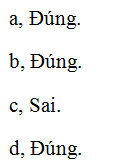Hãy nhập câu hỏi của bạn vào đây, nếu là tài khoản VIP, bạn sẽ được ưu tiên trả lời.

a) Gọi theo thứ tự ∆1, ∆2, ∆3 là giá của các vectơ ,
,
cùng phương với
=> ∆1 //∆3 ( hoặc ∆1 = ∆3 ) (1)
cùng phương với
=> ∆2 // ∆3 ( hoặc ∆2 = ∆3 ) (2)
Từ (1), (2) suy ra ∆1 // ∆2 ( hoặc ∆1 = ∆2 ), theo định nghĩa hai vectơ ,
cùng phương.
Vậy câu a) đúng.
b) Câu này cũng đúng.

A B C D O M N
a)
Các véc tơ cùng phương với \(\overrightarrow{AB}\) là:
\(\overrightarrow{MO};\overrightarrow{OM};\overrightarrow{MN};\overrightarrow{NM};\overrightarrow{NO};\overrightarrow{ON};\overrightarrow{DC};\overrightarrow{CD};\overrightarrow{BA};\overrightarrow{AB}\).
Hai véc tơ cùng hướng với \(\overrightarrow{AB}\) là:
\(\overrightarrow{MO};\overrightarrow{ON}\).
Hai véc tơ ngược hướng với \(\overrightarrow{AB}\) là:
\(\overrightarrow{OM};\overrightarrow{ON}\).
b) Một véc tơ bằng véc tơ \(\overrightarrow{MO}\) là: \(\overrightarrow{ON}\).
Một véc tơ bằng véc tơ \(\overrightarrow{OB}\) là: \(\overrightarrow{DO}\).

a) Đúng
b) Sai vì: \(\overrightarrow{a}+\overrightarrow{b}=\left(0;2\right)\ne\overrightarrow{0}\).
c) Sai vì \(\overrightarrow{a}+\overrightarrow{b}=\left(7;7\right)\ne\overrightarrow{0}\)

Cho hai véc tơ \(\overrightarrow{a};\overrightarrow{b}\).
TenAnh2
TenAnh2
A = (-4.3, -5.94)
A = (-4.3, -5.94)
A = (-4.3, -5.94)
B = (11.06, -5.94)
B = (11.06, -5.94)
B = (11.06, -5.94)
D = (10.84, -5.94)
D = (10.84, -5.94)
D = (10.84, -5.94)
E = (-4.36, -5.86)
E = (-4.36, -5.86)
E = (-4.36, -5.86)
F = (11, -5.86)
F = (11, -5.86)
F = (11, -5.86)
TenAnh1 TenAnh1 A = (-4.3, -5.94) A = (-4.3, -5.94) A = (-4.3, -5.94) B = (11.06, -5.94) B = (11.06, -5.94) B = (11.06, -5.94) D = (10.84, -5.94) D = (10.84, -5.94) D = (10.84, -5.94) F = (11, -5.86) F = (11, -5.86) F = (11, -5.86) E = (-4.3, -5.98) E = (-4.3, -5.98) E = (-4.3, -5.98) G = (11.06, -5.98) G = (11.06, -5.98) G = (11.06, -5.98)

Có \(\overrightarrow{a}.\overrightarrow{b}=\left|\overrightarrow{a}\right|.\left|\overrightarrow{b}\right|.cos\left(\overrightarrow{a},\overrightarrow{b}\right)\).
Vì vậy:
\(\overrightarrow{a}.\overrightarrow{b}< 0\) khi \(cos\left(\overrightarrow{a},\overrightarrow{b}\right)< 0\) hay \(90^o< \left(\overrightarrow{a},\overrightarrow{b}\right)\le180^o\).
\(\overrightarrow{a}.\overrightarrow{b}>0\) khi \(cos\left(\overrightarrow{a},\overrightarrow{b}\right)>0\) hay \(0^o\le\left(\overrightarrow{a},\overrightarrow{b}\right)< 90^o\).
\(\overrightarrow{a}.\overrightarrow{b}=0\) khi \(cos\left(\overrightarrow{a},\overrightarrow{b}\right)=0\) hay \(\left(\overrightarrow{a},\overrightarrow{b}\right)=90^o\).

a) \(\overrightarrow{a}=2\overrightarrow{u}+3\overrightarrow{v}=2\left(3;-4\right)+3\left(2;5\right)=\left(6;-8\right)+\left(6;15\right)\)\(=\left(12;7\right)\).
b) \(\overrightarrow{b}=\overrightarrow{u}-\overrightarrow{v}=\left(3;-4\right)-\left(2;5\right)=\left(1;-9\right)\).
c) Hai véc tơ \(\overrightarrow{c}=\left(m;10\right)\) và \(\overrightarrow{v}\) cùng phương khi và chỉ khi:
\(\dfrac{m}{2}=\dfrac{10}{5}=2\Rightarrow m=4\).


